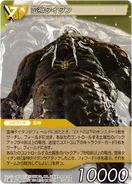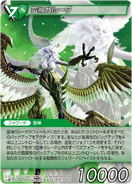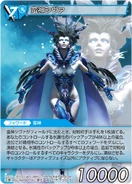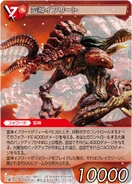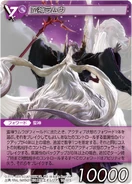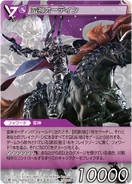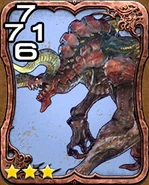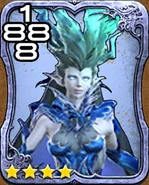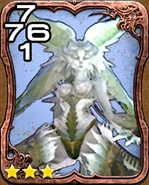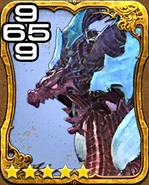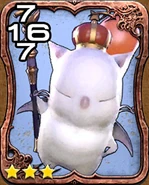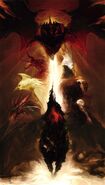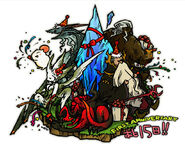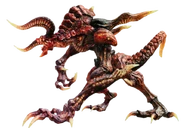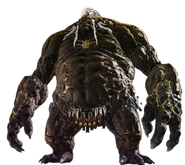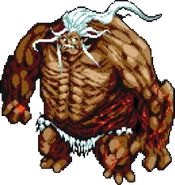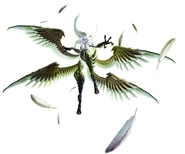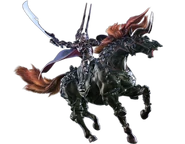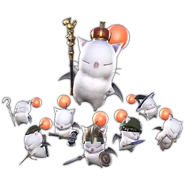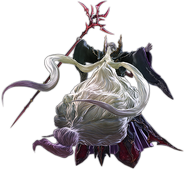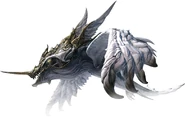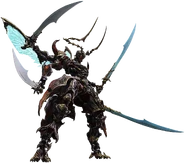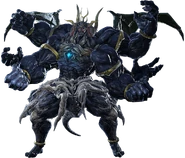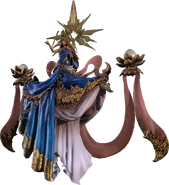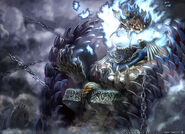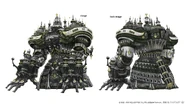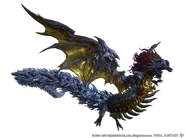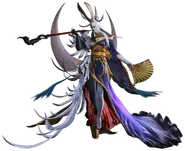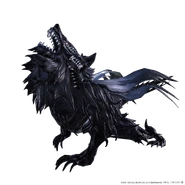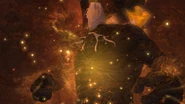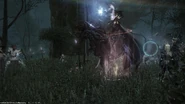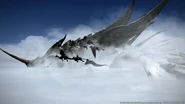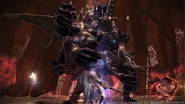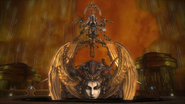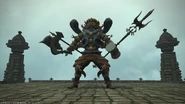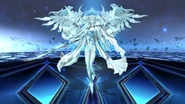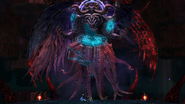
I couldn't miss the chance to practice my drawing!

Oh, shut up and help me remodel the Primal page!
- Revise gameplay section to include more detailed appearances of enemies as bosses.
- Revise the history section to ensure everything copacetic.
This request can be discussed on the associated discussion page. Remove this notice upon completion.
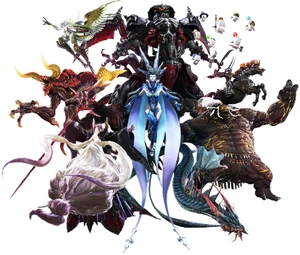
Some of the primals of Final Fantasy XIV along with the Ultima Weapon and the Mogglesguard.
O mighty Ifrit, Lord of the Inferno and Champion of Sun! Thy humble servants have summoned Thee forth from the boundless aether, that Thou might cleanse these heathens' souls of their transgressions with Thine holy flames.
Amalj'aa transfigurator
Primals (蛮神, Banshin?, lit. savage gods), known as eikons [ˈaɪ.kɒn] (闘神, Tōshin?, lit. war gods) by the Garlean and Allagan Empires, and eidolons [aɪˈdoʊ.lən] (幻魔, Genma?, lit. phantom spirits) in the Thirteenth, are magical beings in the world of Final Fantasy XIV. Primals often take the form of gods and other legendary figures, quickened and maintained by aether provided in the form of crystals or artefacts. In Eorzea, primals tend to be summoned by "beast tribes" and are based on classic Final Fantasy summoned monsters. Many primals "temper" their followers, enthralling them into seeking to worship them and expand their following by allowing them to temper others. Those who possess the Echo or the Blessing of Light are able to resist their mind controlling properties. Primals and their threat to the world are one of the main stated reasons for the Garlean Empire's expansion.
Profile[]
Primals are possessed of terrifying power, and are effectively immortal─they can return from death's halls no matter how many times they are slain. They are wont to bless their beastman worshippers with spiritual and physical strength, and the city-states deem them a most dire threat.
Official website
Primals are constructs of concentrated aether made manifest by the will of the summoner, often in the form of legendary figures or mythical creatures. Primals are a variation on the ancients' creation magicks, based on the "deity" concept. However rather than using a crystalized concept as the basis of the summoning, they instead make use of worship by multiple people to maintain a solid vision of the summoned primal, which allows the lesser aether and power of modern races to successfully manifest them.
Modern primal summoning is often the result of rituals taught by the shadowy Ascians. Due to being results of an intentionally corrupted versions of the deity concept, these primals must constantly consume aether from their surroundings, eventually rendering the surrounding area lifeless and uninhabitable, thus becoming a threat to the world itself. Primals wrought through these rituals tend to enthral their summoners and other beings in an effort obtain new adherents and worshipers that will continue to offer them aether and prayer. However not all primal summonings follow these corrupted rituals and not all primals temper their subjects or threaten to drain the land dry.
Primals and the tools used to summon them have proven capable of undoing Ascians, as the supply of aether needed to summon a primal can, if focused, shatter an Ascian trapped in White Auracite. Further, a primal can consume an Ascian's soul directly after their host body is slain; as primals feed on aether and a soul is comprised of it.
Due to the presence of primals in Eorzea and the massive amount of aether needed to summon and sustain them, the land of Eorzea is in peril of being drained if the corrupted summonings are not stopped. The Scions of the Seventh Dawn thus strive to eliminate any primals that manifest. This is also one of the stated reasons behind the Garlean campaign to conquer the world. Gaius van Baelsar hoped to achieve a permanent means through the Ultima Weapon's ability to absorb primals. While both the Scions and Emperor Varis seek to stop summonings, their methods differ greatly. The Scions seek to repair relationships to stop conflicts that lead to primal summoning while Varis seeks to exterminate all peoples that have the capacity to summon a primal.
Origins[]
The deity concept was first created during the Final Days of the ancients, based on the study of the "Terminus" beast Archaeotania. Using that concept the first proper primal, Zodiark, was summoned by the Convocation of Fourteen to stop the effects of the Final Days, summoned from a sacrifice of half of the population of the star. After another sacrifice of half of the remaining population to restore the land to life and a forthcoming sacrifice of newly formed life, an opposing faction summoned Hydaelyn to oppose and bind Zodiark.
Following the sundering, the remains of the Convocation, reformed into the Ascians, propagated a corrupted and unsustainable form of primal summoning in order to cause mass destruction and bring about Umbral Calamities to free Zodiark from his bonds. To that end, the Ascians introduced these summoning rituals to disenfranchised peoples throughout Eorzea, that they would feel the need to summon their gods and heroes to aid them.
Primal summonings[]
Originally, primal summoning was achieved with sacrifices and the deity concept, resulting in permanent forms. The prototype Guardian Force, Quetzalcoatl, took the life of the summoner to protect Akadaemia Anyder. Meanwhile the first proper primal summoning took a mass sacrifice of lives to achieve continual existence and desired effects, with further sacrifices increasing their scope. Both Zodiark and Hydaelyn required a "heart" for the primal, a core of their being that controlled their will and embodied the manmade deity.
Modern summonings still require copious amount of aether, substituting concepts with worship to maintain the primals' forms. Given that, compared to the ancients, modern peoples have little aether and ritual summoning requires an ample supply, modern summoning often uses external sources of aether, the most convenient being crystals. This can also be acquired via other tools and artefacts suffused with aether, such as the enigmatic horn and tablet stored on Seal Rock, the staff Tupsimati, or the eye of a great wyrm.
Multiple instances of the same primal cannot normally be summoned at once, unless the variation on the primal is different enough that they act as a "new" primal. Primals also have continuity of consciousness each summoning.
A slain primal is not truly dead and can be re-summoned at any time. However, each iteration's power varies depending on the amount of aether used during the initial summoning and the amount of tempered thralls currently alive to worship it. For example, the primal Ifrit was notably weaker the first time the Warrior of Light fought it compared to the second time due to more crystals being used to summon the latter iteration. Sacrificing the lives, flesh, and bone of a primal's worshippers will produce stronger versions of a primal rather than just using aether crystals alone. Additionally, while primals do have their own personality, certain traits can be influenced by the thoughts and feelings of the participants in the summoning ritual. One iteration of the primal Titan, summoned by Ga Bu, behaved more like the grieving kobold that summoned it and lashed out at both man and kobolds alike instead of being the protector of kobolds made to fight Limsa Lominsa.
While usually an embodiment of the summoners' desire, there are cases where the summoner transforms into a primal, effectively "summoning" the primal unto themselves, mirroring the original primals which were each formed around a "heart", that being a person acting as the will of the primal. A primal can also be summoned into a structure or be created in the image of their namesake.
Primal summoning can also be spontaneous or accidental, such as with the summonings of Enkidu and Susano. However, as these are not summoned by the Ascian's rituals, they seemingly have no inherent danger of tempering.
Some primals are engendered not through worship, but through the use of "trigger weapons", weapons created by the self-sustaining Allagan primal Eureka. These weapons take control of their wielders, tempering them and turning them into the body of the primal, while the weapon itself is the "actual" primal.
Summoners[]
The discipline of magic known as summoning, created during the days of ancient Allag, was a practice used to combat primals. Originating before the aetherochemical revolution that turned Allag into an empire, summoners are capable of bringing forth part of a primal's power to bear. By summoning these smaller manifestations of the primals, known as egi, summoners were capable of combating primals with their own powers and the powers of other primals.
Tempering[]
Once summoned, primals can "temper" other beings, instilling fanatical loyalty and creating a secure wellspring of faith. For ancient primals, tempering was a byproduct of their enormous power, with Zodiark tempering the remaining members Convocation of Fourteen by His mere summoning. For modern primals, tempering is not inherent except for those summoned by the Ascians' corrupted rituals. Usually this is an intentional process, but some primals, such as Ramuh, show distaste for the act. Other primals, notably Ifrit, actively seek out people to temper. While those gifted with the Echo are immune to Tempering their soul's aether may still be consumed by a nearby primal if they ever lose their mortal form.
As the enthralling nature of a primal was included as part of the summoning method spread by the Ascians, summoning in its pure form does not cause enthrallment, unless the summoned being is massively powerful.
Each primal has a term correlating to its element and their form of tempering.[1] Five such terms for the thralls are known: Leviathan's "drowned", Ramuh's "touched" (as in "touched" by the primal's divine influence), Odin's "sundered" (due to how his blade tears one "asunder"), Lakshmi's "dreamers" (in reference to the "blissful dream" that she offers her thralls) and Ifrit's "tempered". The term "tempered" has also come to be the default term for such thralls, as Ifrit's tempered are some of the most common and numerous thralls.
Tempering is a result of overaspecting the aether of a creature towards a primal's element. This can eventually lead to physical changes if they are further exposed to the primal's aether. Even if the aether of the tempered subject were to be return to normal, their memories of their time under the effects of tempering would keep them fanatical
Long thought to have been impossible to cure, the Grand Companies of Eorzea's citystates had as policy to slay those tempered in an effort to limit summoned primal's powers. A method of curing tempering was invented by Alisaie Leveilleur with the help of recovered research by the Allagan scientist Owen. This cure is administered through the use of porxies, but it cannot cure those physically transformed by their tempering.
Binding[]
Often, primals not able to be slain, are bound in attempts to stop their potential or actively destructive abilities. Hydaelyn bound Zodiark on the moon with Her powers over passivity, splitting His essence in 14 shards and spreading each to one of the reflections of the Source.
The Ascians, as part of their plots to engineer a Calamity, taught the Allagan Empire the means to bind primals. The Empire used this technology to bind the Warring Triad (Final Fantasy XIV) and, with the help of Omega, Bahamut. The Allagan Empire also created the Ultima Weapon using the Heart of Sabik auracite, that was able to capture primals and use their essences to power itself up.
The Allagan primal Eureka itself was later bound by Galuf Baldesion and his comrades underneath the Isle of Val in an effort to eventually extinguish the self-sustaining primal by "reversing the flow" of aether, draining it of aether until it was extinguished. This seal was later possibly reactivated by the Warrior of Light, Krile Maya Baldesion, and Ejika Tsunjika.
During the Seventh Umbral Calamity, as the elder primal Bahamut was released and in its rage nearly destroyed Eorzea, Louisoix Leveilleur used Tupsimati and the prayers for salvation of Eorzea to summon primal versions of The Twelve concentrated into a spell that attempted to bind Bahamut, but ultimately was unable to contain the beast. This spell would later be repeated and completed on the primal Shinryu by his student Papalymo Totolymo at the cost of his life. The primal was later bound again by Omega and captured by the Garlean Empire.
The Garlean Empire continued the Allagan Empire's experiments with capturing and using primals to empower warmachina, revamping the Ultima Weapon and eventually developing it's own Weapon Project that would birth various anti-Eikon Warmachina that were capable of absorbing Primals and use their abilities.
The primal Alexander, having power over time, sealed itself away in infinite time stop in order to remove itself from the stage of history and stop itself from causing a calamity.
Known primals[]
Eorzean primals[]
Divine seeds were ever wont to quicken in Eorzea's fertile soil. We need only lead men to the field, and by their eager hands shall a new deity arise.
These primals are those usually created by faith and sacrifice by collectives like beastmen and other disenfranchised populations, though some of them are recreated from memories and ideas. These are capable of enthralling people as long as their victims are not already influenced by a more powerful entity or possessed of the Echo or Blessing of Light.
The term "elder primal" indicates those worshiped/summoned in older eras (i.e. before the Sixth Astral Era), often from cultures that no longer exist. For example, Bahamut was originally summoned in the Third Astral Era, whereas Shiva is a recent "newborn" primal. Unukalhai mentions that the term the Allagans used for primals is "eikons".[2] Given the time between Allag's fall and the present, this would mean all the eikons from the Allagan era are elder primals since they have been around for at least 5,000 years.[3]
- Ifrit, Lord of the Inferno, primal based on the god of the Amalj'aa.
- Titan, Lord of Crags, primal based on the god of the kobolds.
- Garuda, Lady of the Vortex, primal based on the god of the Ixal.
- Good King Moggle Mog XII, primal based on the ancient moogle king and savior of the ancestors of the Mogglesguard.
- Phoenix, a primal of rebirth created from Louisoix Leveilleur during the Sixth Umbral Calamity.
- Leviathan, Lord of the Whorl, primal based on the god of the Sahagin.
- Ramuh, Lord of Levin, primal based on the god of the sylphs.
- Shiva, Lady of Frost, primal based Saint Shiva, worshipped by the Ishgardian heretics and summoned into Ysayle Dangoulain.
- Ravana, Lord of the Hive, primal based on the god of the Gnath.
- Bismarck, Lord of the Mists, primal based on the god of the Vanu Vanu.
- Knights of the Round, primals based on King Thordan and his Knights Twelve, created by Archbishop Thordan VII using the Ishgardians' faith in their country's founding legend in conjunction with one of Nidhogg's eyes, embodied by the Archbishop Thordan VII and his Heavens' Ward.
- Alexander, the Iron Colossus, primal based on the designs of the Illuminati goblins shared in the Enigma Codex.
- Shinryu, the Wyrm, a primal summoned by Ilberd Feare using his hate, the desperation of dying Ala Mhigans and the aether of Eyes of Nidhogg to lay waste to the Garlean Empire.
- Lakshmi, the Lady of Bliss, primal based on the god of the Ananta.
- The Twelve, primals based on the patron deities of Eorzea summoned during the Battle of Carteneau by Louisoix to seal Bahamut.
- Rhalgr, the Destroyer, primal that was planned to be summoned by youths from Little Ala Mhigo, though this plot is halted before the primal could be summoned.
Eurekan primals and trigger weapons[]
Primals created by the primal Eureka, which often take the form of "trigger weapons" that temper their wielders, turning them into an extension of the primals themselves.
- Eureka, elder primal sealed in the Forbidden Land, Eureka. It manifests as a masked man, and creates trigger weapons that enthrall their wielders.
- Odin, the Dark Divinity, a roaming elder primal. A trigger weapon, the sword Zantetsuken is the primal, while Odin is a mortal whom the primal blade tempered and blessed with power.
- Art and Owain, primals sealed within the Baldesion Arsenal. Trigger weapons, the weapons Ostralltach and Moralltach are the real primals.
- Raiden, primal sealed within the Baldesion Arsenal. A trigger weapon, the sword weapon Shin-Zantetsuken is the real primal.
- Absolute Virtue, a primal sealed within the Baldesion Arsenal. A trigger weapon, the weapon Virtuous Lance is the real primal.
- Proto-Ozma, a primal sealed inside the Baldesion Arsenal. Unlike other Eurekan primals, it is not a weapon possessing an individual.
- Excalibur, a primal sealed within Eureka Orthos. A trigger weapon, it is a sword possessing a man named Artorius and used as a living weapon by the Allagan Empire before being sealed under the Crystal Tower.
- The Queen, Vengeful Eikon, elder primal based on the legendary Queen Gunnhildr of Bozja, with power originating from an Allagan trigger weapon.
Ilsabardian and Othardian primals[]
Primals summoned outside of the lands of Eorzea are less common, but no less dangerous.
- Susano, the Lord of Revel, primal based on one of the kami worshiped by the Kojin.
- Tsukuyomi, Goddess of the Moon and Divinity of night. A primal based on a kami worshipped by the Kojin, summoned in the body of Yotsuyu goe Brutus.
- Unknown primal, absorbed by the Ruby Weapon.
- Unknown primal, absorbed by the Emerald Weapon in the mountains of Ilsabard.
- Unknown water based primal, absorbed by the Sapphire Weapon in the Corvos Narrow.
- Asura, False Mansuya, a primal based on a Thavnarian goddess of war.
Meracydian primals[]
Primals summoned by various Meracydian tribes in their effort to stave off the encroaching Allagan threat.
- Bahamut, the Dreadwyrm, elder primal summoned by the dragons of Meracydia in the image of the first brood of the same name. He was bound within Dalamud until the Seventh Umbral Era.
- Sephirot, the Fiend, first member of the Warring Triad and an elder primal summoned by a tree-like race in Meracydia.
- Sophia, the Goddess, second member of the Warring Triad and an elder primal summoned by a multitude of Meracydian races. Sophia is supported by the giant head Barbelo, though both are the same entity.
- Zurvan, the Demon, third member of the Warring Triad and an elder primal summoned by Meracydian centaurs.
Eden primals[]
Imitation primals created in the First of Hydaelyn's reflections. They are entities created through memories from the Warrior of Light by the sin eater Eden.
- Ifrit, Heritor of the Inferno, Norvrandt's version of the Lord of the Inferno made from the Warrior of Light's memories.
- Garuda, Heritor of the Vortex, Norvrandt's version of the Lady of the Vortex made from the Warrior of Light's memories.
- Raktapaksa, Heritor of Fury, fruit of the fusion between the Heritor of the Inferno and the Heritor of the Vortex.
- Titan, Heritor of Crags, Norvrandt's version of the Lord of Crags made from the Warrior of Light's memories.
- Leviathan, Heritor of the Whorl, Norvrandt's version of the Lord of the Whorl made from the Warrior of Light's memories.
- Ramuh, Heritor of Levin, Norvrandt's version of the Lord of Levin made from the Warrior of Light's memories.
- Shiva, Heritor of Frost, Norvrandt's version of the Lady of Frost made from the Warrior of Light's memories and summoned into Ryne.
- Cloud of Darkness, Abyssal Abhorrence, a primal recreated by the Warrior of Light's memories of the voidsent of the same name.
- Shadowkeeper, Ravening Antihero, a primal recreated by Mitron based on her memories of the form used by Cylva to face Ardbert and his group.
- Fatebreaker, Dread Hope, a primal recreated by Mitron based on Ryne's memories, hopes and fears, based of the idea of Thancred turned into a sin eater fused with Ran'jit's familiar Gukumatz.
Ancient primals[]
Primals originating from the world unsundered.
- Quetzalcoatl, Guardian Force, prototype of a primal summoned in Akadaemya Anyder.
- Hydaelyn, Divine Light, elder primal of Light summoned around Her heart, Venat, long considered the will of the star by the "enlightened races".
- Zodiark, Eternal Darkness, elder primal of Darkness and manmade god of the Ancients. Fashioned to be the original will of the star.
- Elidibus, the Heart of Zodiark made manifest with the original Elidibus's personality and memories, who eventually takes on the form of the original Warrior of Light.
Lunar primals[]
Primals created by the Telophoroi towers using captive "beastmen" tempered by Anima into becoming devoted to the Garlean Empire, forcing them through torture to create twisted versions of their deities who exist to fight for Garlemald. Unlike other Ascian created primals, these lack the ability to enthrall people.
- Anima, Eikon of Eikons, primal created by Fandaniel using the Garleans' faith in their deceased Emperor Varis. It is the source of the Lunar primals and the Telophori towers.
- Lunar Ifrit, recreation of the Lord of the Inferno forcibly summoned by the Telophoroi using captive Amalj'aa.
- Lunar Bahamut, Telotherium, a recreation of the Dreadwyrm summoned by Meracydian dragons enthralled by the Telophoroi.
- Lunar Odin, a recreation of the Dark Divinity summoned by Fandaniel.
- Lunar Ravana, a recreation of the Lord of the Hive summoned by Fandaniel.
- Magus Sisters, Harbringers Elect, recreations of Thavnairian goddesses summoned by Fandaniel, fought in the Tower of Zot.
- Daivadipa, a recreation of another Thavnairian deity summoned by Fandaniel in the Tower of Zot.
Other primals[]
Various other primals have appeared or otherwise been implied through the game.
- Enkidu, primal inadvertently summoned by Gilgamesh, based on the memory of the original Enkidu.[4]
- Belias, elder primal from the Allagan era. Was slain by High Summoner Sari and his apprentices. The art of summoning Belias-Egi is imparted unto Tristan Lowe, by an Ascian. While a Lucavi bearing this same name appears in the Ridorana Lighthouse and uses similar egi to support himself, the nature of the Lucavi makes the relation between the primal and it uncertain.
Additionally, other primals have been referenced but have not had their existence confirmed. Valefor is a primal mentioned by Gagarua, although it's mention was used as a distraction. While enemies named Valefor appear in the Labyrinth of the Ancients, these are voidsent dahaks, and as such, it is unknown if a primal by that name has ever existed. Similarly, the Burn was believed to be a land drained from aether because of repeated primal summonings, but this was eventually revealed to be propaganda disseminated by Emperor Solus zos Galvus, and that the true reason for its aether loss was ancient Allagan technology used to create the floating islands of Azys Lla, leaving it unclear if any primals existed around the area before this.
In the Thirteenth, many unnamed eidolons were vanquished by memoriates, sealing them in memoria, corrupting those who weilded them, causing them to turn into voidsent
Egis and other manifestations[]
Summoners can evoke manifestations of primals they have encountered and partially absorbed the aether of. Additionally, some primals can create egis and minions of their own that are extensions of the primal's power.
- Summoned by the Warrior of Light
- Carbuncle, summoned by summoners who first learned the discipline of magic known as arcanima, who focus their summons through gemstones.
- Ruby Carbuncle, Emerald Carbuncle, Topaz Carbuncle variations of Carbuncle that can be summoned by summoners versed in arcanima. By changing the way they shape the aether of their evocations, these can also be glamoured over other summons.
- Ifrit-Egi, evoked by summoners who have been in the prescence of the Lord of the Inferno.
- Garuda-Egi, evoked by summoners who have been in the prescence of the Lady of the Vortex.
- Titan-Egi, evoked by summoners who have been in the prescence of the Lord of the Crags.
- Demi-Bahamut, an aspect of the Dreadwyrm Bahamut evoked by the Warrior of Light after defeating the Evocation Matrix.
- Demi-Phoenix, an aspect of Phoenix evoked by the Warrior of Light that can be summoned thanks to the firebird's aether permeating Eorzea after the Calamity.
- Ruby Ifrit, a more full aspect of Ifrit, resembling the Lord of the Inferno more clearly, evoked by the Warrior of Light. It is unknown how they achieved this feat.
- Emerald Garuda, a more full aspect of Garuda, resembling the Lady of the Vortex more clearly, evoked by the Warrior of Light. It is unknown how they achieved this feat.
- Topaz Titan, a more full aspect of Titan, resembling the Lord of the Crag more clearly, evoked by the Warrior of Light. It is unknown how they achieved this feat.
- Solar Bahamut, a variation of Bahamut more similar to his original incarnation, with the addition of wings composed of swords, evoked by the Warrior of Light. It is unknown how they achieved this feat. Its abilities resemble those of Hydaelyn.
- Summoned by others
- Belias-Egi, evoked by Tristan Lowe at the service of an Ascian.
- Cochma and Binah, minions of Sephirot.
- Sephirot Binah, Sephirot Egi, evoked by the Summoning Node.
- Sari-egi, evoked by the Summoning Node following Sari's ancient instructions.
- Suparna and Chirada, minions of Garuda.
- Suparna-Egi and Chirada-Egi, egi versions of the minions, evoked during the Austerities of Wind.
- Phoenix-Egi, evoked by the Phoenix itself.
- Grey Arbiter, minions of Rhamuh.
- Granite Gaoler, minions of Titan.
History[]
Before Final Fantasy XIV[]
When the Final Days propagated by the Endsinger came to Etheirys, the Ancients' creation magicks were warped as their fear-driven mental states caused them to unconsciously bring to life monsters based on their deepest fears. One such creature, Archaeotania, first rose on the opposite side of the planet to Amaurot, the capital of the ancient world. Seeking to study the creature, Amaurotine researchers captured it and brought it back to Akadaemia Anyder where they studied it and its properties to devise the creation of the "deity" concept, made from the aether of individual peoples, with the prototype "Guardian Force", Quetzalcoatl being created from this research.
Recognizing the cause of the Final Days to be the stagnation of aetherial currents, the Convocation of Fourteen prepared to create a deity that could quicken the aetherial currents, summoning Zodiark, the first primal. To give Him the strength to stop the Final Days, the Convocation ordered the mass sacrifice of half of the world's population in His summoning, causing a rift in the ancients' society and the abandonment of one of their members. Following another sacrifice of half of the remaining population to restore the world and allow it to once again sustain life, the Convocation, tempered by Zodiark and dedicated to bringing back their sacrificed comrades, prepared to sacrifice newly formed life to the primal in order to restore their people. As a response, Venat and her followers summoned the second primal, Hydaelyn to bind and restrain Zodiark, sacrificing their lives to create Her. The pair's conflict sundered the world into the Source and its thirteen reflections.
The three members of the Convocation who survived the sundering with their souls intact—Emet-Selch, Elidibus, and Lahabrea—reformed themselves as the Ascians to conduct Umbral Calamities to restore their original world and free their god. During this time they developed the modern technique of primal summoning, a corrupted version of their creation magicks that drained more aether and forced tempering, and taught it to various disenfranchised peoples of the shattered worlds in the form of prayer for the aid of their deity, altering the process to revolve around faith rather then conception.
On the Thirteenth shard, the Ascians orchestrated the summoning of primals, there called eidolons, to bring about a Darkness aligned Flood in an attempt to reintegrate the shard to the Source. People with special powers, known as Memoriates, were able to seal these eidolons in magicite crystals known as memoria. However the memoria was flawed, causing the eidolons' energies to leak out and corrupt the memoriates, turning them into creatures of Darkness, eventually known as voidsent.
On the Source, primal summoning took center stage in world history during the time of the Allagan Empire, where their expansion saw them fighting against the peoples of Meracydia. There, the Ascians orchestrated summoning of "eikons" from Meracydian natives, giving birth to the Warring Triad. In addition, the Ascians taught summoning to Tiamat and her brood after the Allagan Empire had murdered her brother-consort, Bahamut, with promises that the summoned primal would be their kin returned. Simultaneously, the Ascians aided the Allagans in the creation of technology to capture and imprison eikons, which led to the primal Bahamut being imprisoned in the artificial satelite Dalamud, which became known as a moon after the fall of the Allagan Empire.
Version 1.0[]
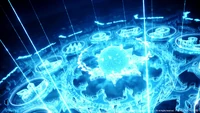
The Twelve are summoned at the Battle of Carteneau.
A decade prior to the events of the game, the death of the dragon Midgardsormr during the Battle of Silvertear Skies broke the seal he had placed on Silvertear Lake to contain the aether beneath it. The Ascian Paragons used this to teach the summoning ritual to the Eorzean beast tribes, with the resulting primals providing added motivation for the Garlean campaign.
The adventurer was made aware of the primals by the Elezen mage Louisoix Leveilleur, leader of the Circle of Knowing, whose investigation of Garlean Legatus Nael van Darnus revealed the primals' absorption of the realm's crystals threatened Eorzea. When van Darnus enacted "Operation Meteor", Dalamud's descent towards Eorzea weakened the primals as it absorbed their aether.
During the Seventh Umbral Calamity, the lesser moon Dalamud was revealed as Bahamut's prison. Louisoix tried to partially summon the Twelve, Eorzea's guardian deities, to reseal Bahamut, but the attempt failed and Bahamut's rage was unleashed on the realm, triggering the Seventh Umbral Era. In the catastrophe's aftermath, the beast tribes focused on rebuilding.
Final Fantasy XIV: A Realm Reborn[]
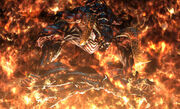
Ifrit.
Thancred Waters and the adventurer investigated mystery disappearances in Camp Drybone, encountering Amalj'aa that had been kidnapping people to be offered to their primal, Ifrit. During the operation to catch the Amalj'aa red-handed, the adventurer was betrayed and knocked unconscious to be turned into Ifrit's follower. Through Hydaelyn's protection, Ifrit's fire had no effect on the adventurer and they went on to defeat him.
The Maelstrom, the Grand Company of Limsa Lominsa requested the newly christened primal slayer to slay Titan, whom Kobolds near the city had summoned. Y'shtola Rhul warned the adventurer that Titan was much stronger than Ifrit, and that advice from the Company of Heroes, a brave band of men and women who had in the past killed him, would come in handy. After performing a series of tasks for the Company members, the Adventurer received their blessing and entered Titan's lair, where their group defeated him.
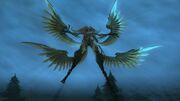
Garuda.
Later on, the adventurer worked with Cid and Alphinaud to reach Garuda where the Ixal had summoned her in Natalan. Garuda was much more powerful than the previous two primals, able to retain her physical form even after seemingly being beaten. She proclaimed to tear down each city-state and leave behind a world where she was revered. Before she could attack the adventurer again, Gaius van Baelsar arrived and mocked her, slaying the Ixal whose prayers were powering her. Garuda ripped Ifrit and Titan into existence from their followers whom the Ixal had captured and prepared to feed upon their aether. Van Baelsar deployed the Ultima Weapon that defeated Garuda and the other primals.
After the defeat of the Garlean Empire and the resurrected primals, Alisaie Leveilleur asked the newly christened Warrior of Light to investigate the remains of Dalamud beneath Castrum Occidens to uncover the mystery behind Bahamut's sudden disappearance during the Calamity. There they found fragments of Bahamut's body, and at the center saw its head held in place by technology from Dalamud. They glimpsed Louisoix and Nael van Darnus, alive, watching over Bahamut. Unable to do any more, the two took their leave.
The Sahagin accumulated enough crystals to summon their primal, Leviathan.[5] After being warned by the Scions of the Seventh Dawn of the impending crisis, Admiral Merlwyb Bloefhiswyn mobilized the Maelstrom in launching a preemptive strike against the Sapsa Spawning Grounds. They found a Sahagin priest calling forth Leviathan, who claimed to achieve eternal life through the Echo. He transfered his mind into the bodies of fellow Sahagin after the Admiral shot him, but the awakened Leviathan simply absorbed him. To take out the Lord of the Whorl on the open seas before he could unleash a catastrophic tidal wave, a special barge called the Whorleater was created to enable the Warrior of Light to approach and defeat the ocean primal.
The touched Sylphs called forth Ramuh, Lord of Levin.[6] The sylphs of Little Solace had previously assured Ramuh was of minimal concern, focused only with the protection of the forest, and it was believed that an influx of refugees from the unrest in Ul'dah had pushed the touched ones' hands into summoning their primal. When the Scions confronted him, the Lord of Levin condemned the actions of man. Questioning the Warrior's resolve to be the Bearer of Light, Ramuh bid them to undertake his trial. Once defeated, he granted the Warrior of Light his blessing and left the physical world.
The heretic Ysayle Dangoulain summoned forth Saint Shiva as a primal.[7] Being a user of the Echo, she could channel the primal into herself, becoming its avatar—a feat previously unknown. The Warrior of Light defeated Shiva who reverted to Ysayle. Frustrated, she condemned the Warrior's involvement, insisting she was acting for the sake of peace.
Final Fantasy XIV: Heavensward[]
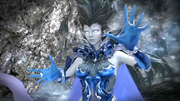
Shiva.
The Gnath, a tribe of arthropod-like beings native to Dravania, became increasingly belligerent to both dragons and hunters. The dragon Vidofnir revealed that the Gnath had summoned a primal, and this had put the dragons on edge and thus denied the Warrior of Light, Ysayle, Alphinaud, and Estinien Wyrmblood access to the dragon Hraesvelgr for the time being. The Warrior of Light and Ysayle let themselves be captured as offerings to the primal, Ravana. Realizing the primal was a war god, Ysayle offered a trial by combat, asking the Gnath to abandon their conquest should they defeat him. In the first round, Ysayle transformed into Shiva to duel Ravana, but was defeated. The Warrior of Light was up next, and triumphed against the primal, who honored his word.
In the Sea of Clouds, the Vundu tribe of the Vanu Vanu summoned Bismarck as a primal, an immense whale capable of devouring the floating islands, including the one that housed the key to Azys Lla. Cid Garlond concocted the idea of towing a floating island via airship as bait, and installing Ishgardian Dragonkillers to harpoon the whale, allowing the Warrior of Light to defeat the Lord of the Mists at the Limitless Blue.

King Thordan and his Knights Twelve.
Archbishop Thordan VII and his elite knights, the Heavens' Ward, had used Ascian teachings to channel the legend of King Thordan and his Knights Twelve as a primal of the church. At the floating continent of Azys Lla, Thordan used the power of Nidhogg's right eye to transform into King Thordan with the intent of eliminating all conflict in the world and ruling as a God-King. As his first act, the primal executed the Ascian Lahabrea and absorbed the Ascian overlord's aetherial essence. The Warrior of Light defeated the Knights of the Round in the Singularity Reactor. Alexander awoke in the Dravanian Hinterlands, while the Warring Triad stirred from their slumber.
Later, atop Baelsar's Wall, Ilberd Feare used the Eyes of Nidhogg and the sacrifices of himself as well as his soldiers to summon Shinryu and bring calamity upon the Garlean Empire. Moments after its release, Shinryu was confronted by the recently activated Omega. The battle ended in a stalemate as the clashing energies resulted in a massive explosion that sent both flying away to parts unknown.
Final Fantasy XIV: Stormblood[]
Upon traveling to Tamamizu, the Warrior of Light learned of a creature akin to a primal called Susano, a kami the Kojin of the Red worship. Unlike the primals of before, the Red Kojin did not plan to summon him. Instead, the Warrior of Light unwittingly summoned Susano during a mission to draw Red Kojin away from their imperial allies, as the Yasakani-no-Magatama in the Warrior's possession reacted to two other treasures stored in a vault, materializing into the physical world without either prayer or crystal. Susano desired a contest of wills with the Warrior of Light, his wish for battle independent from the Red Kojin.
After freeing Doma and returning to Gyr Abania, the Warrior of Light learned of another primal from their Ananta allies, called Sri Lakshmi, a deity worshiped by their beast tribe. She has been summoned when Fordola rem Lupis murdered the daughter of the Qalyana's leader, who had previously sided with the Empire in the hope of being left alone. Driving the imperials away with the might of their patron deity, they demanded that the Vira tribe of the Ananta come pay tribute to her. The Warrior of Light, the Leveilleur twins, and Lyse Hext headed to the Qalyana's home to slay the primal.
They saw the Qalyana's broodmother distraught, as although her daughter had been revived, her soul was long ago lost to the aether, leaving behind an unresponsive husk. Alisaie became incensed by the primal's false promises and tried to convince the Qalyana to renounce Lakshmi, but the mother's grief was too profound. The primal flooded the room with a wave of tempering flames, which the Warrior of Light blocked. Lakshmi warned them to leave them be. After they defeated the primal in her lair, the Qalyana broodmother cursed the Warrior of Light and Lyse for taking away their only means of solace and told them to leave for her to mourn.
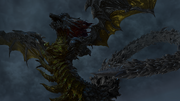
Shinryu.
The Warrior of Light discovered the missing Shinryu within the Royal Menagerie of Ala Mhigo. Zenos Galvus's men had captured and imprisoned the beast while it had been incapacitated from the battle with Omega. Because Shinryu was born of pure rage with no worshipers to guide its power toward a specific target or goal, it was akin to a mindless beast. Taking advantage of this, Zenos used the Resonant within his being to merge with Shinryu, becoming the primal itself with its power at his disposal. The Warrior of Light later fought and destroyed Shinryu, leaving behind Zenos's battered body and the now powerless eyes of Nidhogg.
After Ala Mhigo's liberation, the Qalyana joined with the leading Resistance members to discuss the matter of the throne. Though the broodmother had spoken of harmony with her fellow Ala Mhigan neighbors, she revealed her true plan to summon Lakshmi, calling her forth in front of the leaders to temper them, having used the enthralled guards to smuggle in the crystals. Amid the chaos, Raubahn Aldynn cut down the broodmother while Arenvald Lentinus and the Warrior of Light used their Echo to shield the civilians and leaders from her influence. Lakshmi's advances became overwhelming, but unexpected help arrived when Fordola, released from captivity, stepped in and used her Resonant powers to protect the Ala Mhigans from a blast that would have otherwise ensnared them. With their combined power, the three slayed the primal, saving countless lives from a lifetime of servitude.
During the prisoner exchange between Doma and Garlemald to solidify the united front against primals, Asahi sas Brutus planned to disrupt the negotiations by forcing Yotsuyu goe Brutus to regain her memories, bringing her back as acting viceroy of Doma. The supply crates he had taken from Yanaxia were, in fact, crystals, and the mirror he had given her prior was used as a catalyst for the summoning of a kami. Feeding upon her sorrows, the crystals transformed her into Tsukuyomi. Asahi uses Yotsuyu's summoning ritual to breach the agreement and ordered his men to retreat. As the Warrior of Light battled her, they beared witness to Yotsuyu's innermost turmoil, being overwhelmed by specters of those who had wronged her, though a single light defended her in the form of a ghost of Gosetsu Daito. Yotsuyu succumbed to her hate, but was defeated. Remnants of the primal's power still lingered in her transfigured state, but Asahi repeatedly shot her. Yotsuyu used her remaining power to skewer him with swords. Her vengeance sated, she died peacefully, her lifeless body returning to its original state.
Final Fantasy XIV: Shadowbringers[]
In the absence of the Warrior of Light (who had journeyed to the First, one of the shards of the Source), Ifrit was again summoned. Raubahn enlisted a contingent of Summoners to combat the primal threat, with Arenvald and the newly conscripted Fordola as commanding officers leading the attack. Arenvald's Echo and Fordola's Resonant powers immunized them to the primal's influence and their enhanced strength allowed them to fell the beast.
In the First, the Warrior of Light (now taking on the title of "Warrior of Darkness"), Ryne, Urianger Augurelt, and Thancred Waters discovered a primordial being half-buried in the Empty, known as Eden, deduced to be the first sin eater and the one responsible for the Flood of Light that was eroding the First. They discovered through some investigating of its inner workings that Eden did not erase aether so much as it simply halted its flow. They devised a means to restore the flow through Eden's own power when Ryne took control of it after the Warrior defeated its prime form from within. Urianger speculated that to do so, aspects of aether must be introduced in mass quantities, with each element of the astral kind restoring nature piece by piece. The Scions' solution was to use Eden and the Warrior's memories to evoke primals from the Source and defeat them so that their dispersed aether would restore an aspect of the First.
Focusing on water first, the Warrior's thoughts turned to Leviathan. When confronted its form appeared different, now having two heads. After defeating it, Urianger speculated that its altered form was due to the Warrior's hazy memory of having fought the primal so long ago, and how they could have confused its form with other water-aspected primals they had encountered during their travels. Flowing water returned to the Empty, and they next focused on earth. Titan sprang to mind and his form was also significantly altered, now appearing as a less hefty humanoid covered in large iron tires that it rode upon. With its defeat natural soil returned to the area. Though their successful efforts seemed localized, Urianger theorized that the restored aether may have reappeared in focal points across the world. Ryne, exhausted from the summonings and having spent an extended amount of time in the Empty, regrouped with her friends to Norvrandt.
Upon returning to the Empty with the newly awakened Gaia from an earlier excursion, Urianger proposed to focus on the aspect of thunder, this time summoning Ramuh. The Warrior's memories called forth a centaur, the upper half being a slightly younger version of the wise primal and the lower body of Ixion from Gyr Abania. After defeating him, the crystal outside changed color though no other outward change was apparent. Urianger noticed that the very air was less stifling and more humid. Without wind to carry storms and no fire to evaporate water, the thunder aspect could not be fully realized. Gaia and Ryne proposed to introduce fire and wind simultaneously, requiring the Warrior to fight two primals at the same time. Summoning Ifrit and Garuda, the latter was more or less the same as her original form, but Ifrit was more humanoid in appearance. The two merged to form a new entity called Raktapaska, but were yet destroyed and their combined aether changed the crystal to a red and green bi-color palette, returning rain to the Empty.
With the group's mission nearly complete, they only needed to bring forth the aspect of ice. They were delayed when Gaia's faerie's voice intruded her mind and manifested in physical form as the Idol of Darkness. After destroying the threat and freeing her, the group continued with their mission. Ryne summoned aether into her own being to transform into Shiva, just as Ysayle once did. Despite Urianger and Thancred's objections, Ryne insisted on doing it to prove herself strong enough, should Eden run amok while she was trying to control it.
Shiva manifested in a new form and took over Ryne, attacking the Warrior. Ryne's power as the Oracle of Light further transformed Shiva by turning her into a robed figure resembling Hydaelyn's depiction in the stone walls of the Qitana Ravel. Shiva's power grew unstable and she blasted herself and the Warrior in an explosion of light-aspected ice, freezing them both solid. Gaia emerged from a dark portal and summoned a hammer of darkness to shatter most of the ice, freeing the Warrior. With their combined strength, they destroyed Shiva's form, freeing Ryne from her influence. They celebrated their victory, and with the ice element, greenery returned to the land, completing their mission. Though the planet's rejuvenation could take decades, the undisturbed channeling of Eden's massive power should ensure that all was well in the foreseeable future.

Elidibus's Warrior of Light.
While searching for Y'shtola in Emet-Selch's recreation of Amaurot, the Warrior came across Elidibus, whom Y'shtola deduced as a fragment of the Heart of Zodiark, and thus, a primal fostering faith in the legends of the Warrior of Light across the First to strengthen himself. When the Warrior confronted Elidibus at the top of the Crystal Tower, Elidibus could barely remember his people, his friends, or the reasons behind his actions. Undeterred, he assumed the form of the first Warrior of Light of legend, but the Warrior of Darkness defeated him with the aid of Azem's memory crystal given to them by Hythlodaeus, as well as Emet-Selch's soul. Having been stripped of his power, the Warrior gave Elidibus the memory crystals of the Convocation of Fourteen they has in their possession, allowing the latter to regain his long-lost memories before fading away.
Following the other Scions' return to the Source, the Warrior, Ryne, and Gaia returned to the Empty to discover that the elements were still aspected towards light. Gaia suggested restoring darkness to balance out the light, and summoned a recreation of the Cloud of Darkness. In doing so, they inadvertently freed the Ascian Mitron, Eden's true form. Mitron had implanted the idea of restoring darkness in Gaia's mind, and invited her to Eden to explain their relationship. Mitron used Eden's power to recreate the Shadowkeeper that Ardbert and his friends defeated long ago to reawaken Gaia's memories as his partner Loghrif from the original world of Etheirys. When that failed, he forcibly fused with Gaia to create an Ascian Prime, and created an amalgamation of Ryne's greatest hopes and fears: Vauthry, Thancred, Ran'jit, and the sin eaters.
After the Warrior overcame the Fatebreaker, Mitron refused to release Gaia and transformed into Eden's Promise to confront them directly, intending to erase her memories and create a utopia where time had no meaning. Eden's Promise was defeated and Gaia separated from Mitron, while the area around Eden transformed into a lush and verdant paradise, with the colossal sin eater itself encased in a giant tree. Ryne and Gaia predicted that life would spread to the rest of the Empty in time.
In southern Ilsabard, the Warrior assisted the Bozjan Resistance in retaking their homeland from the IVth Imperial Legion by taking Castrum Lacus Litore in the Bozjan Southern Front. Unbeknownst to the Resistance, the IVth had placed a spy, Misija Votyasch, within their ranks. They found the ancestral weapon of Gunnhildr, Save the Queen, and gave it to Misija, who intended to harness the blade's power. Misija kidnapped Mikoto Jinba, intending to use her to enter the blade's memories as well as become Resonant. When the Resistance retook Castrum Lacus Litore, Misija confronted them and forced the Warrior and Mikoto to enter Save the Queen's memories. She altered them and summoned her ancestor as a primal, and tempered the new generation of Gunnhildr's Blades. Bwagi Ennze Panca arrived before the rest could be enslaved and shot Misija in the shoulder, giving them time to escape.
With the Resistance routed and the IVth's forces bolstered by Misija and the elder primal, despite their lack of movement due to lack of resources from Garlemald, both were left at an uneasy stalemate. Mikoto revealed that Save the Queen had been crafted from auracite created by Ultima, the High Seraph, meaning that it could not be sustained with a substantial cache of crystals. Pursuing Misija to the ancient Bozjan ruins of Delubrum Reginae, they cornered her and her forces and discovered that the blade had lost its power; however, this turned out to be a trap, as her Resonant powers granted her clairvoyance into the future. The Warrior and Mikoto pursued Misija into the ruins while she found suitable stores of aether to restore the blade's power. Channeling her primal ancestor, she directly engaged them, but was defeated and the Resistance took her into custody to await trial.
Emboldened by the victory at Castrum Lacus Litore, the Resistance planned to strike Zadnor, the Empire's last stronghold in Bozja. When the IVth launched the main cannon of battleship Dalriada, Misija once again assumed the form of Queen Gunnhildr to protect the Resistance. She died of her wounds afterwards, and Save the Queen was sealed in the restored country of Bozja.
Within the Garlean Empire, a group known as the Telophoroi, led by Zenos Galvus and Fandaniel, used the corpse of the murdered Emperor Varis to create the primal Anima. The Telophoroi then created towers around the world to siphon aether from the planet and to temper beings to be loyal to Anima, and the Empire by extension. The Telophoroi would kidnap various beast tribesmen and imprison them within the towers to summon Lunar primals, variations of the original primals created through the prisoners of the Telophoroi's towers. These primals were powerful and executed the Telophoroi's orders, but appeared to lack any semblance of a personality and could not temper anyone. The Scions and the Grand Company of Eorzea defeated Lunar Bahamut in Thanalan, and later Lunar Odin, Lunar Ravana, and Lunar Ifrit at Carteneau.
Final Fantasy XIV: Endwalker[]
At Thavnair, the Warrior of Light learned about Thavnairian gods, the Magus Sisters: Cinduruva, Sanduruva, and Manduruva. The sisters were summoned by the Arkasodara who were held against their wills inside the Tower of Zot to defend it.
In Garlemald, Fandaniel kidnapped the Warrior of Light and divulged he had transformed the deceased Emperor Varis into "the eikon of eikons", Anima, to temper all Garleans and collecting aether from all over Eorzea to shatter Zodiark's seal. The Warrior of Light's party defeated Anima inside the Tower of Babil, but Fandaniel already had the aether he needed and tried to summon Zodiark. Hydaelyn guarded the last seal, so Fandaniel and Zenos departed to the moon to remove the last brand. Hydaelyn hindered them by using magick to strand the two on the other side of the moon.
The Warrior of Light departed to Mare Lamentorum on the moon where they learned that Zodiark was the one protecting the star against the Final Days that had laid waste to the original world, Etheirys. Fandaniel and Zenos arrived and the Ascian destroyed the last seal before fusing with Zodiark and challenging the Warrior of Light to a battle. The incomplete Zodiark was destroyed and the Final Days fell upon the star.
After learning the Final Days' true cause from the distant past, the Warrior of Light and the Scions of the Seventh Dawn arrived in the aetherial sea to ask Hydaelyn Herself for Meteion's location. Hydaelyn challenged the group before they would confront the Meteia at the edge of the universe to see if they could end the song of oblivion. Finally surpassed by mankind, Hydaelyn gave the Warrior the mothercrystal to power their ship while imbuing their crystal of Azem with creation magick. With Hydaelyn fading away, the primals of the ancients were no more.
Back at Labyrinthos, Krile revealed that the Sharlayan governing body, the Forum, had an idea how to empower the spaceship Ragnarok by converting some of the mothercrystal's aether into primals, with the beast tribe representatives channeling the purest form their deities through the Loporrits' creation magick; as the Loporrits confirmed the known method had been devised by the Ascians to include enthrallment and that it was not inherent to a primal's existence, this new method would ensure no enthrallment would occur. The beast tribes' representatives summoned Ramuh, Ifrit, Titan, Garuda, Leviathan, Good King Moogle Mog XII, Ravana, Bismarck, Susano, and Lakshmi to empower Ragnarok until it reached the edge of the universe where Meteion made her nest.
When the Warrior of Light stood alone after the Endsinger blew all of the Scions back, Zenos arrived in the form of Shinryu. He had agreed to help the Scions defeat Meteion, and gorged himself on what remained of the mothercrystal to chase them. The Warrior and his summoned friend then battled the Endsinger upon Shinryu's back. When the Warrior of Light and Zenos commenced their final duel, Zenos could still call upon Shinryu's powers, but he was defeated regardless, this time for good.
Gameplay[]
Primals primarily appear as part of the game's scenario as boss fights within instances. They are regularly fought in Trials and Dungeons. However, there are means by which players can summon versions of them similar to classic summoning systems from the Final Fantasy series.
Egi[]
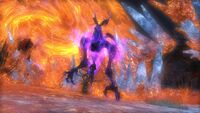
An egi of elder primal Belias summoned.
Egi are tiny versions of primals available for the Summoner job. Players are only allowed to summon egi versions of Ifrit, Titan, and Garuda, but much larger and more fully-formed versions of Bahamut and Phoenix can be summoned via Demi-Bahamut and Demi-Phoenix, respectively.
These creatures are made of concentrated elemental essence. Only Summoners can call them forth after binding their power with the aid of their Soul Crystal. These egi bear many characteristics of the respective primal, but lack the personality and aether-draining properties of the full-scale forms. Some primals summon minions that resemble egis, such as Ramuh's Grey Arbiters and Titan's Granite Gaolers.
After Summoners achieve level 90, they can summon Ruby Ifrit, Topaz Titan and Emerald Garuda, which empowers their attack spells and replace their Carbuncle.
Magicite[]
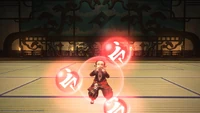
A player using a Heaven-on-High magicite.
In the Heaven-on-High Deep Dungeon, players have a small chance of receiving magicite only for use inside said dungeon. Magicite summon a simulacrum of certain primals, based on the user's memories of past encounters with them.
These kind of summons are similar to those from other Final Fantasy titles by making their appearance just to unleash their signature attack before leaving.
Players are able to summon Ifrit, Titan, Garuda, and Odin. The former three instantly kill all normal enemies on the floor and deal roughly 20% damage to bosses, while also granting temporary invincibility. Odin will instantly kill even bosses, but is extremely rare, and best saved for the final boss on floor 90 if acquired.
Lord of Verminion[]
The Lord of Verminion is a minigame from the Manderville Gold Saucer in which players can summon their minions to fight in the arena, each of them using different abilities.
As of patch 6.5, 23 of the 51 known primals have their own minions: Odin, Bahamut, Ifrit, Titan, Garuda, Leviathan, Ramuh, Shiva, Alexander, Ravana, Bismarck, Lakshmi, Susano, Shinryu, Tsukuyomi, Absolute Virtue, Cloud of Darkness, Save the Queen, the Magus Sisters, Anima, Hydaelyn, Zodiark, and Daivadipa.
Triple Triad[]
In the Triple Triad minigame, Primal is a type of card. These cards feature primals encountered through the game.
Other appearances[]
Final Fantasy Trading Card Game[]
Some primals appear as cards.
Final Fantasy Portal App[]
Some primals appear as Triple Triad cards.
Behind the scenes[]
On the bonus disc included with the physical collector's edition of Final Fantasy XIV: A Realm Reborn, Midgardsormr is erroneously referred to as an elder primal.[8]
Gallery[]
- Artwork/renders
- Screenshots
Etymology[]
The Garlean word "eikon" (borrowed from the Allagans) may derive from the Greek word eikon, translated in English as "image", which is the root word for the English work "icon" whose early definition was religious imagery.
Citations[]
- ↑ Letter from the Producer LIVE Part XXVII Digest (02/10/2016) (Accessed: November 29, 2018) at Official ''Final Fantasy XIV'' forums
- ↑ Final Fantasy XIV, Quest "Gods of Eld"
- ↑ Gods of Eld (Accessed: November 29, 2018) at gamer escape
- ↑ One Primal, Two Primal, Red Primal, Blue Primal (Accessed: November 29, 2018) at Developers' Blog for ''Final Fantasy XIV''
- ↑ Final Fantasy XIV, "Through the Maelstrom"
- ↑ Final Fantasy XIV, "Defenders of Eorzea"
- ↑ Final Fantasy XIV, "Dreams of Ice"
- ↑ The Waning of the Sixth Sun (Accessed: November 29, 2018) at gamer escape

